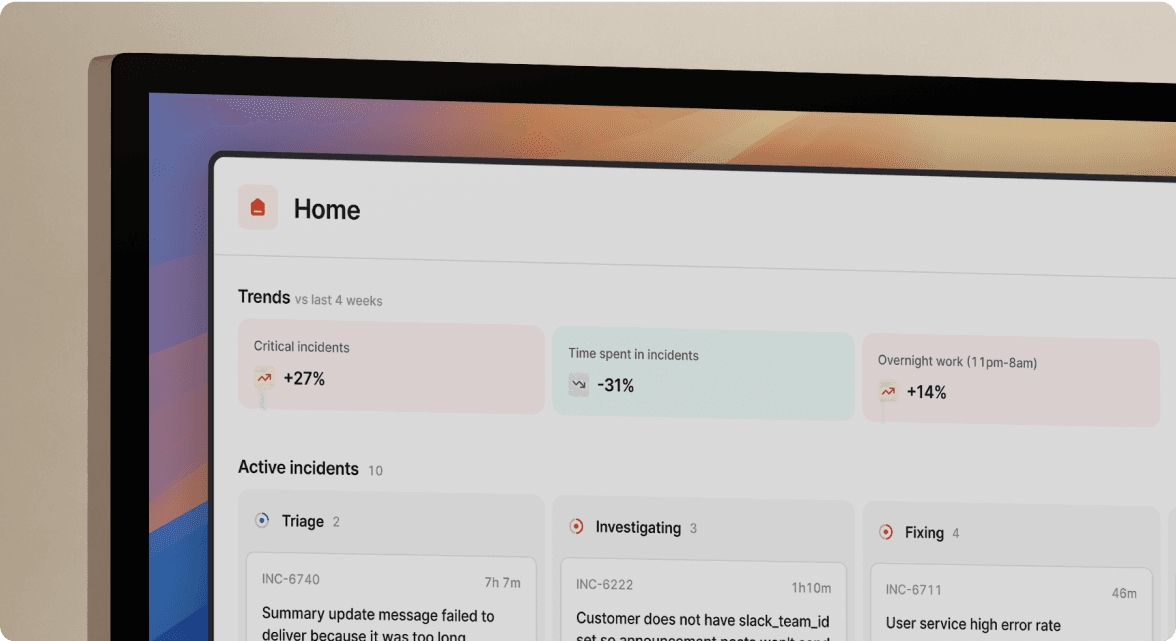Improvements to the Slack channel experience
November 21, 2023

Our product has grown a lot over the past couple years, so we wanted to reinvest in the overall Slack experience so it continues to feel great even throughout the chaos of resolving an incident.
We’ve been spending recent weeks ensuring that we are only posting in the incident channel when we know we are adding loads of value, avoiding too much extraneous vertical space and building foundations to help us ship features faster in the future (without re-cluttering the channel!).
We’re still working on it, but here is a sneak peek of some of the initial pieces of work we’ve done to make the Slack experience feel a little smoother.
Grouping users in an incident

When you’re in an incident, if you’re assigning roles, actions or follow-ups, you usually want to assign it to someone who’s already been involved in the incident. We now group the relevant drop-downs in Slack and in the dashboard so that we prioritise the folks that are in the incident (active first, then observers, then everyone else).
Streamlined subscription messages

We've polished the subscription messages you receive when an incident is created that matches your subscription criteria, or when an incident you're subscribed to is updated.
Now, these messages all have the same layout of information to make them easier to parse. We’ve moved buttons and extraneous links to the overflow menu, and we’ve added Slack avatars to highlight who made the incident update.
Keeping the start of the incident tidy

We’ve re-worked the way we set up a new incident channel, meaning that everything will always happen in a consistent order so it’s easier to parse (inviting the reporter and setting the topic first, then the introductory messages, followed by any other automations).
We’ve also polished the messages themselves, so that they take up a bit less space on the screen and are easier to read.
🚀 What else we’ve shipped
New
- You can now manually trigger a re-sync from the web UI for a catalog type that we manage
- You can now configure a custom field so that its options change depending on another custom field that’s powered by the catalog
Improvements
- Opening incident modals is now noticeably faster
- The workflow editor background now extends to the full height of the window
- Internal status pages now correctly shows learning flow updates as resolved updates
- Our reinstallation banner no longer pushes content down below the fold of the screen
- Label the time zone we use in the 'incident pulse' graphs
- When duplicating a workflow that's within a folder, the new copy will be created within the same folder
- When creating a Jira export template, we'll now always show the 'template name' input so the content doesn't move around unexpectedly
- If you move an incident's Jira ticket to a different project within Jira, we'll keep trying to sync it. If the new project has incompatible required fields, we'll drop a message in the incident channel.
- Debrief invites we create in Google Calendar will now have a Google Meet link attached
- Searching within all inputs now matches 'L' with 'Ł', 'c' with 'ç', and 'n' with 'ñ'
- When opening a modal using a keyboard shortcut, focus will start on the first input, rather than the close button
- We can now sync a code block in an incident summary to a connected Jira ticket
- The workflow editor background now extends to the full height of the window
- Internal status pages now correctly shows learning flow updates as resolved updates
- Our reinstallation banner no longer pushes content down below the fold of the screen
- Opening incident modals is now noticeably faster
Bug fixes
- Make sure links in a form’s help text work properly inside Slack
- Fix scheduling of monthly round-up emails around daylights savings time zone changes
- Internal status pages can now use catalog types with many thousands of entries
- When editing timestamps for an incident, the 'automatically set' section can be collapsed as well as expanded
- When multiple incidents have a similar name, we would sometimes rename the incident channel multiple times in a row, causing some channel noise. Now we don't!
- When using Slack Enterprise Grid, pinning a message in another workspace's incident channel will now add the message to the incident timeline
- Status page sub-pages render the header and footer correctly on 404 pages
- When using Slack Enterprise Grid, pinning a message in another workspace's incident channel will now add the message to the incident timeline
- Status page sub-pages render the header and footer correctly on 404 pages
So good, you’ll break things on purpose
Ready for modern incident management? Book a call with one of our experts today.

We’d love to talk to you about
- All-in-one incident management
- Our unmatched speed of deployment
- Why we’re loved by users and easily adopted
- How we work for the whole organization



